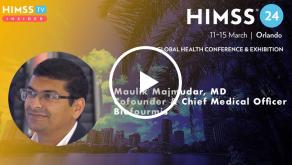Can technology restore humanity to healthcare?

"At its core, technology would seem to be the antithesis of humanity," said Dr. Chris DeRienzo, chief quality officer at Asheville, North Carolina-based Mission Health System. "It doesn't feel, it doesn't think and it can't see the humanity of the person in front of it."
Ask physicians how they feel about electronic health records, or read Atul Gawande's recent New Yorker feature, "Why Doctors Hate Their Computers," and it's apparent that most healthcare professionals' relationship with technology is ambivalent at best.
"It's tempting to say there's no way we can build or leverage technology in order to restore some humanity to the practice of medicine," said DeRienzo. "But I think that's fundamentally a wrong assumption."
At HIMSS19 on Tuesday, in one of the new TED Talk-style SPARK Sessions, titled "Humanity and Technology in Medicine: Antithetic or Symbiotic?" DeRienzo will explain why.
The reason technology seems to pull us away from people, rather than bring us together, mostly boils down to "how we've designed it and what we've designed," DeRienzo said. But rethinking both of those, IT could be repositioned in a way where it enhances, rather than detracts, from the clinician and patient experience.
With funny personal anecdotes and real-life case studies, he'll show how technology, properly deployed, can restore joy to healthcare – helping burnt-out physicians better engage person to person, and enabling them to practice at the top of their license and use their skills to solve complex challenges
"If we focus on the right types of technology, and we build it right, then we can actually use it to empower people to do more of the things that only people can do in healthcare," said DeRienzo.
How technology is designed, and what it's used for, plays a big role in how well it is liked by its end users. Consider tech that's intentionally created to connect people, such as telemedicine. "We see much more positive reaction to it."
EHRs, on the other hand, were not designed with joy in mind. They were developed under certain conditions, with necessary check-the-box functionalities related to regulatory compliance and billing capture.
And they were "based on a world where we took what we did on paper then did the same thing on computers," said DeRienzo. "They effectively ignored a lot of the human factor elements for how to design a way to document and record care electronically."
But EHRs are only one challenge, he said. "Our monitors are another. How we use algorithms is another very important one."
DeRienzo predicts that "our electronic documentation will evolve drastically over the next few years as we move away from this built environment and toward a world where human factors matter a whole lot more."
In the meantime, he sees one technology doing a lot to return humanity to healthcare. One that may seem ironic, to say the least, given the trepidations many have about its potential to disrupt and displace: artificial intelligence.
"AI stands positioned to be one of the core technological advances that allows us to return humanity to healthcare," he said.
For example, he explained, "we've built a machine learning model at Mission Health, and we've now gotten it fully up and running. Its purpose is to help risk-stratify patients who our case managers need to focus on. To serve them, not only by a ranked-ordered list but a concept as to why our model thinks they may be at a high risk of being readmitted."
That's a fairly basic AI application, "but its purpose is to pull out things that people don't have to be doing so now my care manager team can spend less time wondering who to focus on and more time actually focusing on people," said DeRienzo.
Ditto with radiology, he said: "I don't think that reading a thousand normal chest X-rays brings radiologists a ton of joy. But doing the really complex work – is it this, is it that? – is what they enjoy. How do we bring the expertise and brains of these terrific musculoskeletal and neuroradiologists to the things we actually need them to be doing? That is how something like AI can actually empower humans."
The practice of medicine is an ancient art, and one that's long depended on the power of human interaction, he explained.
"At one point that was all we had – other than leeches and bloodletting, all we had was the ability to interact with our patients one on one and be human with them," said DeRienzo.
"We've vastly improved our ability to care since then, but in some ways we've lost an appreciation for that aspect of a clinician-patient relationship," he explained. "My fervent hope is that once we get this right, we'll actually be returning, somewhat, to a place where it's that person-to-person relationship that's the most valuable part of our day."
Chris Derienzo's HIMSS19 SPARK session, "Humanity and Technology in Medicine: Antithetic or Symbiotic?" is scheduled for Tuesday, February 12, from 3-3:30 p.m. in room W300.
























